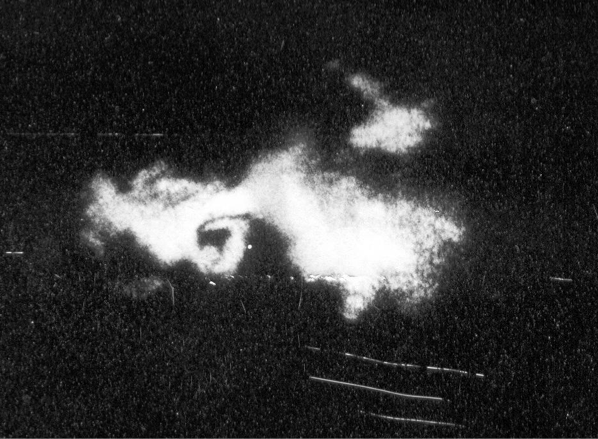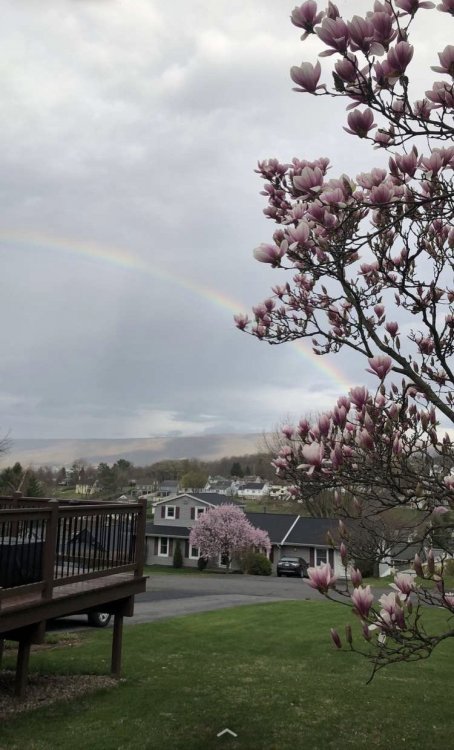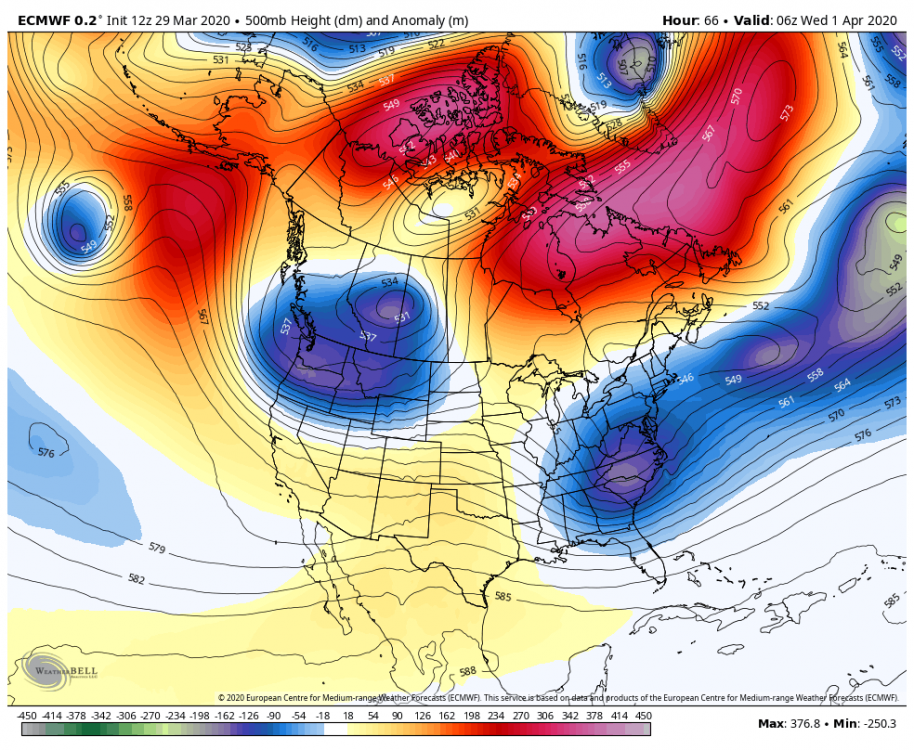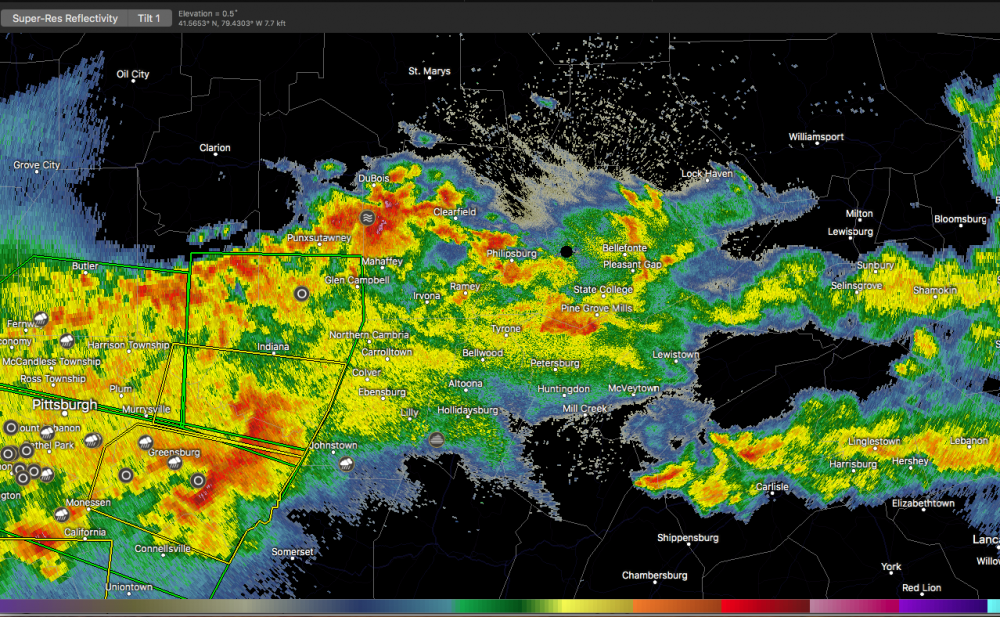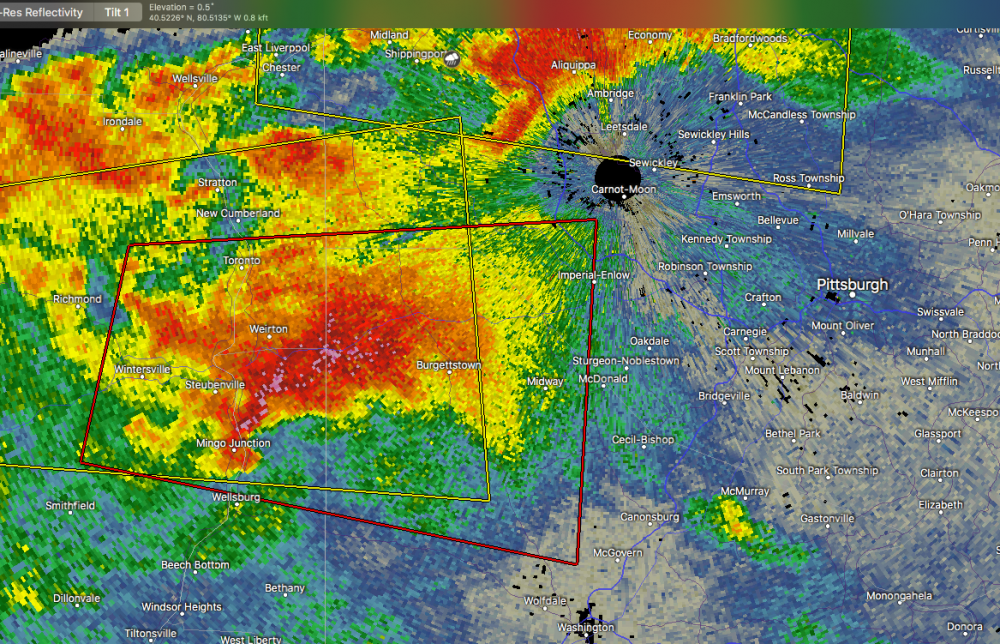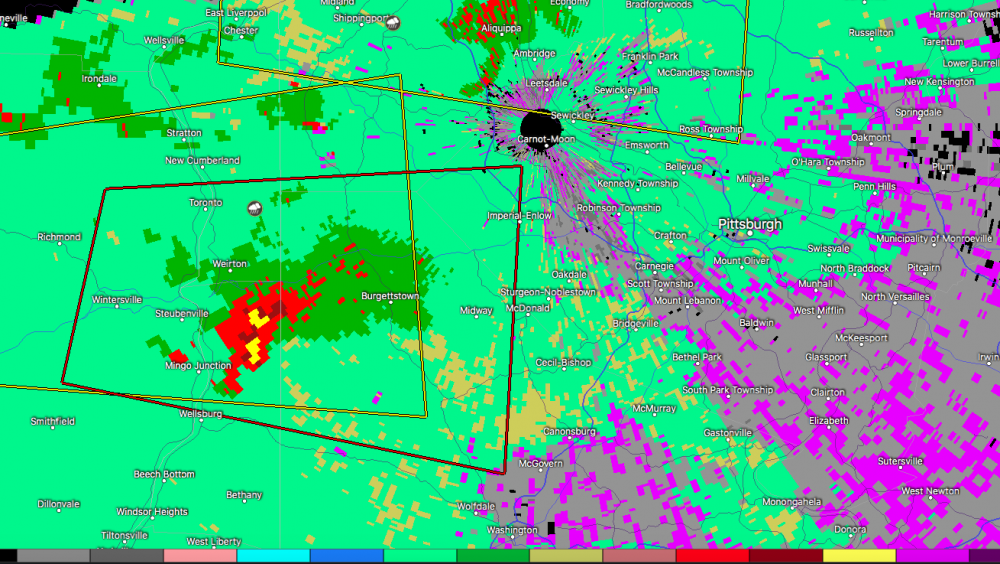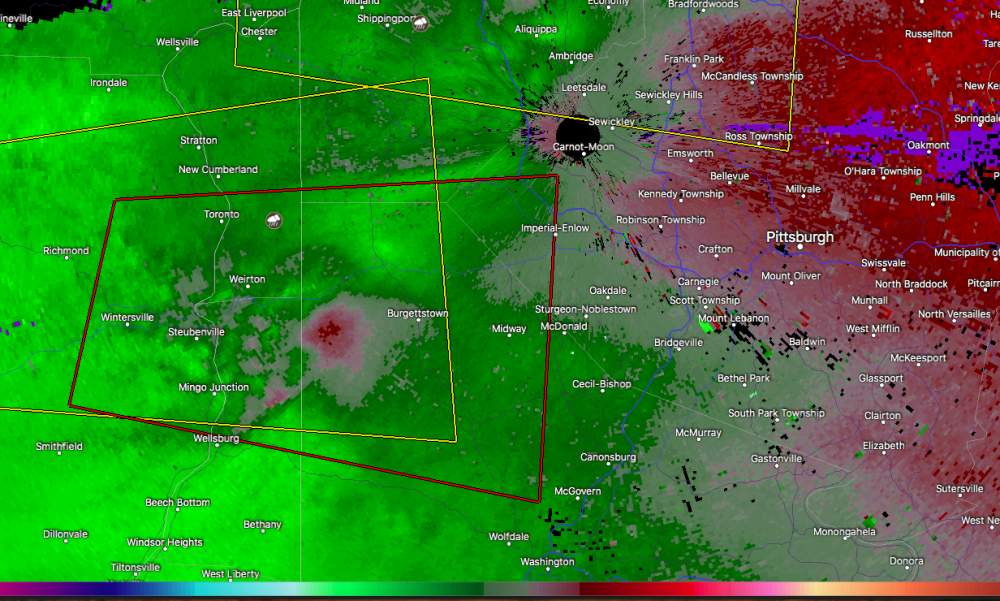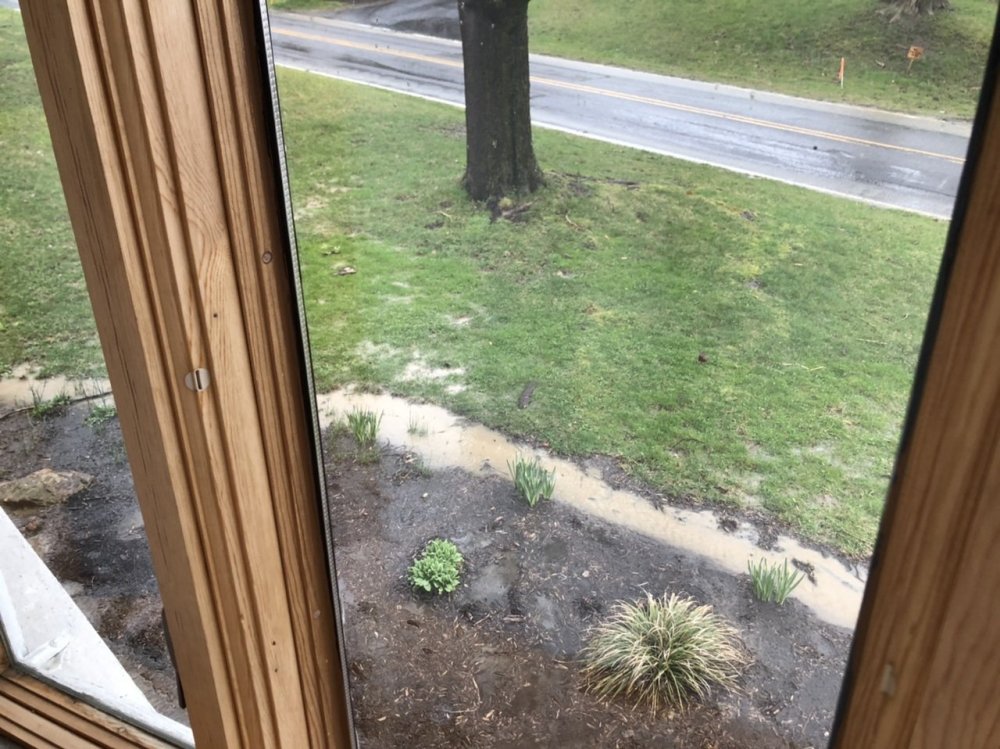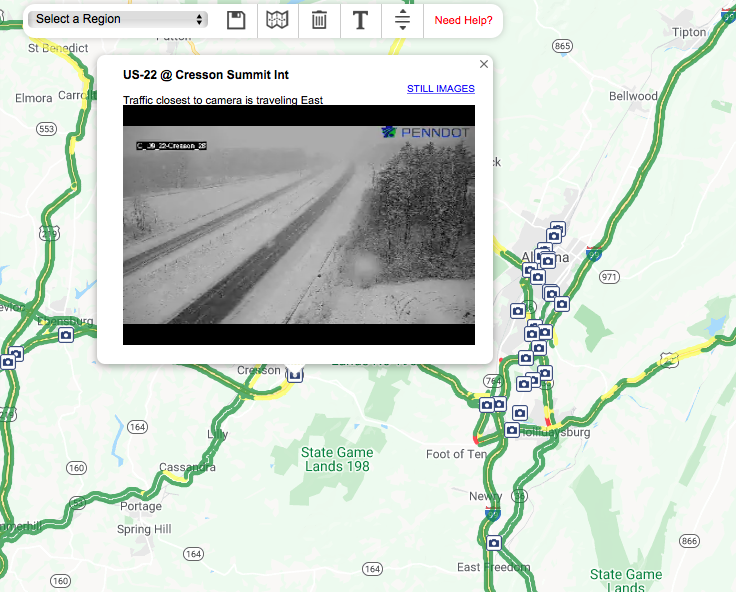
MAG5035
Meteorologist-
Posts
5,939 -
Joined
-
Last visited
Content Type
Profiles
Blogs
Forums
American Weather
Media Demo
Store
Gallery
Everything posted by MAG5035
-
If there was ever a tornado that flies in the face of that theory, that particular tornado was it. That was at the time I believe one of the widest tornadoes ever recorded and it ripped a swath in the woods of Northern Clearfield and Clinton Counties, where it is quite mountainous. I think the only reason it probably wasn't rated an F5 was because that storm miraculously tracked nearly its entire 70 mile path in the part of PA where there literally isn't anything else other than state forest, so there really wasn't anything else to rate damage-wise other than the sheared and uprooted trees. That was during the time when the original Fuguita scale was used. That outbreak featured a setup in western PA that day more reminiscent of what you would see in major plains outbreaks, large CAPE coupled with the proper shear. Certainly the terrain in central PA is much more often than not detrimental in the aspect of having the prime setup for a classic tornadic outbreak. But if you achieve that setup and you have a long tracked supercell/tornado of that magnitude on the ground, it doesn't matter what the terrain is that it's crossing. And that's certainly the lesson to be learned there. Western PA, and especially NW PA where the absolute worst of that outbreak occurred is probably the part of the state most conducive to stuff like that. Why? Because you can achieve that low level southerly/southwesterly flow more readily. There's no mountains to the west that holds clouds in the low levels and/or maintains a stable surface/boundary layer via a cool air damming scenario. You also have to have a favorable track from the parent low pressure system for an organized severe outbreak (outside of MCS and some derecho events), and that's part of why our "tornado season" is typically in that late May-June timeframe. Here's the best image/loop you'll get of the 85 outbreak. You can see western PA cleared out and it's likely the severe parameters were such that it was able to maintain the supercell responsible for the Moshannon tornado. Also not mentioned much in the details of this outbreak is that this also caused several tornadoes in Ontario as well. Radar image of the Moshannon tornado from the old school radar that was on top of the Walker building at Penn State. CTP's writeup on this , which is a good one with all the weather maps of the setup. https://www.weather.gov/ctp/TornadoOutbreak_May311985
-
That's quite a satellite loop: https://weather.cod.edu/satrad/?parms=meso-meso1-truecolor-96-1-50-1&checked=map&colorbar=undefined
-
Yea I was looking at the 3k NAM and noticed the CAPE getting up into eastern PA. With this dynamic setup and a ton of shear, it doesn't take much CAPE in the equation to have a setup for potential spin-ups. The CAPE the NAM has is more than enough getting a ribbon of 1000+ into eastern PA during the mid afternoon tomorrow and thus the tornado parameters are lighting up, which concerns me. This wind/severe potential statewide looks to have two different areas of focus. Everyone looks to get wind advisory type winds from this system (now issued by CTP). Those western higher elevation counties now in the high wind warning have the bigger wind threat from the significant isoballaric component behind the frontal passage (rapid pressure rise) due to the closer proximity to the deepening low pressure moving up out of the lakes. The Sus Valley has the better chance of severe weather which would easily tap down damaging winds aloft but it's also quite possible that it could be windy before the frontal passage as busting into the warm sector is going to mix the boundary layer and still mix down gusty winds. Amount of clearing is going to be something to watch in the south-central but it probably wouldn't take much with the dynamics.
-
I understand not wanting to see anymore snow and such and posting snow maps and etc.. but I mean the above is referring to a possible event in the 72-84 hour range and this has been on a fair amount of guidance in some form or another for the last several days. Tomorrow's storm is going to end up a sub 970 bomb lifting out of the lakes and that's going to carve out a pretty major trough and cold weather for the midweek. The bigger issue I see right now with that following event is it may be suppressed to much. But if it runs a half decent shot of precip north enough to get into PA in that Wednesday timeframe yes, it's quite probable that it could be snow in some places. That's neither wishcasting nor sugarcoating the reality of PA weather during the early spring.
-
Severe threat with Sun night into Monday's storm system going to hinge on how much we bust into the warm sector and the usual cloud cover issues and whatnot... the latter of which I'm not too keen on. CAPE will probably be limited but I can see a line of storms try to fire near the frontal passage and it wouldn't take much to tap down what looks to be screaming winds not too far aloft. Will probably have to keep an eye on the LSV in particular in terms of severe. Either way, you folks that live in the jet stream over there in the LSV should be delighted to know that this upcoming storm probably poses at least a similar magnitude wind event threat as Thursday's system. May not be as long lived but we could be talking similar wind gusts for some portion of Monday just prior and especially after frontal passage. I'd argue the wind potential is even greater but models seem to run the wind max (and corresponding LLJ max) up the I-95 corridor and they have really have then screaming in NJ and NYC/LI. It's still going to be windy regardless. The usual half decent low that runs up through the lakes typically makes for a breezy post frontal regime. A low of this magnitude winding up over the lakes (to 970ish) is likely to bring the wind headlines with it.. perhaps even high wind criteria for some parts of PA.
-
Reporting thundersnow here. Very robust squalls with heavy snow and strong winds.
-
We'll have to watch the kicker system(s) behind the major Great Lakes storm progged to rip up through the lakes region on Monday, possibly in the next Wed/Thurs timeframe. This weather pattern shaping up on the models for the mid-month timeframe is exactly as I feared for about the whole last half of winter.. certainly not too little but definitely too late. We finally have the amp to the pattern with a well placed and very strong western US/Eastern Pac ridge with the highly anomalous eastern trough to go with it. It looks like it would probably be an anomalous enough pattern for mischief in the snowy form with a well placed/phased system. Models today around D6-7ish have what looks like maybe a northern branch wave digging behind a departing coastal that runs a wave of precip through. That'd probably be enough for flakes at least back this way and especially in the mountains, but probably tough to accumulate with a lighter event being progged. The temps/thicknesses aloft are certainly going to be there for any system but surface temps at the lower elevations with the strong sun will always be an issue this time of the year without an incredibly cold airmass or an intense storm system. It becomes extremely hard to get a widespread PA snowfall after maybe the first week of April. Light snow events in early-mid April aren't too out of the ordinary in the higher Laurel's locations, or even here (i've already seen mangled flakes today). But the April 7,1982 event is about the latest one I can think of for the LSV region, and we're getting past mid-month with this potential pattern later next week. The most extreme historical example is the April 28, 1928 snowstorm in central/western PA i've brought up a few times in the past.. that dumped 1-2 feet in this area and more in the southern Laurels. I remember a powerful nor'easter in mid April 2007 had model projections in the 3-5 day range with excessive snows but ultimately ended up only snowing in the high ground of the Apps. You have to pretty much have the stars align for a bigger event this time of the year. But even without any additional snow events, it looks quite cold and unsettled.. maybe not April 2018 cold but pretty chilly.
-
The magnolia tree started blooming this week and is in full bloom today, roughly 10-12 days earlier than last year. Also did the first full grass cut as well. Guess we’re getting late spring out of the way when it reverts to March later this month. from yesterday:
-
About the only positive to this situation is the environmental impact from all the measures in place having a large portion of the world economy on pause and everyone staying home and doing very little driving. If there was ever an ideal time to study, compare, and observe just how much we impact the environment pollution wise.. it's right now. For example, India is one of the worst countries in the world for air pollution, and now in the middle of their 21-day shutdown the Himalayas are visible from 100 miles away in some portions of the country which hasn't happened in decades. https://weather.com/health/coronavirus/video/himalayas-visible-for-first-time-in-30-years-due-to-lockdown https://www.sbs.com.au/language/english/audio/himalayas-visible-for-first-time-in-30-years-as-pollution-levels-in-india-drop
-
One thing I've wondered about with the daily reports from the state on new cases is just how lagged the test results are.. like are some of the postive results reported for a certain day from a test that was given several days ago or even a week or so? As much as this has spread in some parts of the state to this point... the stay at home/social distancing measures have to be making some kind of a difference that could start showing up in the data soon. But yea, that's going to be a challenge when it comes time to figure out how to restart stuff and not make for another outbreak before we're really equipped to deal with it. I could see certain sectors of the workforce restarting fairly quickly after things stabilize but when it comes to the retail/entertainment/travel related things...ugh. Part of my schooling in addition to my met degree is a minor and also graduate certification in GIS. I know they're trying to get a serious message across, but naturally the cartographer/analyst in me wishes that the health.pa.gov map had a different representation/classification method of the color scheme to the number of cases. Centre County reported 4 new cases on Sunday, bringing the total in that county to 43. Apparently 43 cases was enough to turn the county red on the map (the highest category). So basically Centre at 43 is lumped into the same category as Philadelphia County with 3135 cases. Other than a lot of counties painted red, that big of a range is not really telling me much statistically. 3135 known cases spread over Philadelphia County's 2019 population (est) of 1,584,064 people comes out to 0.2% or about 1 in 505. 43 known cases spread over Centre's 2019 population(est) of 162,385 is about 0.026%... or 1 in 3776. That's a significant difference. It shows that despite Philadelphia County's much larger population, the virus is notably more prevalent there statistically. If your wondering about Lancaster County, it's 0.07% or about 1 in 1471. That's the kind of statistic you want mapped out if you really want a somewhat better picture of the hot spots of this virus at the county level. Obviously, viewing the virus statistics at the city/municipality level would be much more telling but that's not publicly available right now. Lastly, this data only becomes more accurate with testing as many people as you can.. which should have been more of a priority early on in the initial hot spots of where the virus started showing up here in this country, and even now for that matter. Software modeling the potential spread/impact of this virus is only as good as the data being put into it, much like weather modeling in that regard. Might as well just lock that right in, I put my snowblower back in the storage shed on Saturday, haha.
-
We've been generally lucky in this section of the state so far. Blair only had 4 cases reported as of today and we do have a testing site in Altoona. Centre's the county in this region with the most (32) and all things considered that's probably doing okay as well. PSU's spring break was Mar 8-14 and when they suspended in person classes in the middle of that week they pretty much haven't allowed any on-campus students to come back. I'm certainly hopeful those actions may have mitigated what could've been a much bigger outbreak considering 30-35k students with a sizeable number of international students as well as I'm sure, a pretty decent amount that hail from the tri-state area.
-
Yup lol, that just shows how much of a one hit wonder the Jan 2016 blizzard was for that winter and how it divided our area and left some of us nearly high and dry. H-burg would've had a 9-10" season without it.
-
They probably just should have instituted the statewide order right off the bat like most other states have been doing. The last couple days some counties were asking the state to include themselves into the order, like Somerset and Cameron.. where Somerset had a few cases and Cameron only had 1. It seems like a lot of people don't get past the titles of the articles and assume that stay at home means everything will shut down, so there will probably be another run at the store. I think the official "stay at home" could give authorities the ability to enforce the order at least from an informing standpoint, such as pulling someone over to see where they're going and such. But don't believe this state is actually enforcing by actual fines or anything like that right now. Neighboring states like MD and DC are threatening violators of their stay at home orders with a misdemeanor and up to a year in jail (DC no more than 90 days) and a $5000 fine. I see the FL governor finally issued a statewide order today. A little late for that week of so the spring break revelers were on the beaches.
-
Visible satellite imagery (https://weather.cod.edu/satrad/?parms=regional-northeast-dcphase-96-1-100-1&checked=map&colorbar=undefined) shows very clearly the low cloud deck still anchored in over eastern PA this afternoon even after clearing in the mid-high levels. You can see a little bit of erosion of the low clouds from the west and south but we're only a couple hours from sunset and the east probably isn't clearing out by then. The sun did bust out here mid-afternoon and we're in the 60s, but we don't have the high winds that are occurring in the Laurel's and especially west of there in PBZ's zones. The full mixing there is getting temps way into the 70s, even JST is 72 currently.
-
Well for this week in "it figures", hey we have blocking up top! Unfortunately, probably too much so in the case of this potential April 1st event. -PNA western trough and positive tilt alignment also help keep the system suppressed and not really allow for it to amp and try to come up. Even if it does throw up precip, the temps are likely to be really marginal as per usual this time of the year absent a significantly anomalous cold airmass.
-
Quite likely to be some flooding issues around here this evening with this last batch of heavy rain/thunderstorms moving in.
-
Pittsburgh PA Spring and Summer 2020 Thread
MAG5035 replied to meatwad's topic in Upstate New York/Pennsylvania
Tornado warning just issued coming into western PA from Ohio, portions of northern Washington and western Allegheny Counties. You SW PA folks got quite the severe setup, at least on paper (Mesoanalysis). Surface CAPEs over 1500 and Mixed Layer capes near 1000 coupled with modest helicity and pretty good shear/lift are putting out EHI values and lighting up the tornado parameter products. I'd be very watchful of that line of storms as it presses into SW PA and also some potential discrete storms esp south of the city. Of more immediate attention, the hook echo portion of the tornado warned storm looks to be taking aim at the southern suburbs of Pittsburgh eventually (Bethel Park, Mount Lebanon, etc). The north side of this cell likely has significant hail in it as well. Velocity isn't showing a concise couplet but the pronounced hook echo is definitely indicating rotation in this storm. -
This next batch of torrential downpours is here. The elevated instability is definitely present as there's been several cloud to ground strikes.
-
Maybe we'll have actual winter weather and snow chances in December for a change if some of these rumblings about an eventual Nina come to fruition. Most CPC guidance is pointed generally neutral but the CFS v2 has been solidly in nina territory later this year. Just a little bit of time to hone that one in haha.
-
Can’t relate on the underachieving rainfall. Just got crushed with a torrential downpour with some thunder. Lots of standing water in the yard and one of the underground drains at the bottom of the yard was erupting like a geyser. First time I’ve seen that since I moved here a few years ago. It must have been fairly rainy earlier this morning. @canderson I hope your family member is doing better.
-
QPF aside, the two systems would have been likely examples of systems we would have all scored from had this occurred in the dead of winter. The pattern setup is just enough to finally run a couple systems under us but we need significant anomalous cold (compared to March climo) to go with that this time of the year which we don't have.
-
So this is happening about 10 miles from here... and probably at the top of the mountain 4 miles from here as well. It's raining here. Might see stuff like this further up in central and north central at similar elevations.
-
Have had some precip falling for a little while, looks to be mostly or all rain.
-
I don't think this storm is necessarily a loss track-wise, the main issue is what I mentioned the other day about precip intensity vs very marginal temperatures. Although, I suppose a bump NW with this initial shield of WAA precip doesn't help with the earlier portion of this event where the best chance for initial snowfall is.. esp central and SE. It's chilly and quite dry in front of this system, like last week. The snow potential on the lead up this week was certainly viable.. If we had a solid slug of moderate to heavy precip targeting the region late tonight into tomorrow morning, most of us would likely be receiving an accumulating wet snowfall. The problem is a separation from the initial precip which seems destined more toward the north central and the blossoming precip associated with the developing coastal low. Timing of the latter is later tomorrow, when the strong high (which doesn't have extremely cold air to be tapped anyways) is off to the east and the delay in the onset of more decent precip allows for daytime warming of the already highly marginal low level temps. Thus, we still have a viable snow threat in the north central region (esp at higher elevations) where this initial wave of precip will impact the most and where it will remain just barely cold enough as the coastal takes over. Unfortunately for the central and Sus Valley, whatever potential flakes may be seen is going to be dependent on if we can develop a band of WAA precip. Early looks at the HRRR haven't been too enthused about that. The radar looks okay (much better for the north central eventually) but one has to be mindful of the dry air in place. Just another case of close but not enough... fundamentally the same problems are still there. I still think the continued +AO coupled with the quietly persistent -PNA is outdoing what the recently turned negative EPO regime could have done for our region without that counterbalance. The AO is at nearly +5 right now, and the pattern alignment over the CONUS favoring eastern ridging at 500mb won't allow for this system to really amp. The EPO may have helped enough to finally get something under us, but we're not cold enough...and we're way late in the season to rely on marginal. The system later this week may well take about the same track as tomorrow's system, but it doesn't appear that it will have enough cold to work with outside of the higher north central.
-
Models and ensembles are still generally supportive of this snow threat on Monday, which I think could be in the cards for most in here. The Euro still leads the way but has edged down accums and shifted north a tad. Some of the runs this week on that model were looking March/November 2018 worthy. Obviously the elevated central and north central parts of the state stand the best chance of seeing any kind of decent accumulations, but we could see accumulating potential even in the Sus Valley. Surface temps are going to be very marginal and it seems that timing is heading towards most of this event being in the daytime though, especially east. I think the biggest thing I see from the models is the snow potential appears to be rate driven. The column temps are there enough if we have a wave of heavier precipitation, and we're going to need a several hour burst of heavy precip to realize any white on the ground with the surface temps.

